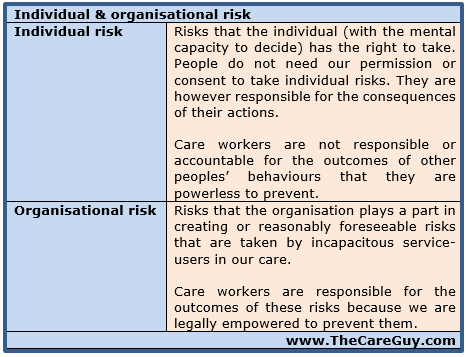 This series of blog posts first appeared a few years ago on a now defunct blog called ‘Care Training’. It was inspired by the training maxim of ‘making the unconscious conscious’. It is intended to take what really ought to be the most basic principles of health and social care and put them down on paper. The series isn’t only an exercise in stating the obvious though whatever the title might suggest. It’s actually intended as a philosophical foundation manual for workers and informal carers to help them get their care ‘on track’ and then to keep it that way.
This series of blog posts first appeared a few years ago on a now defunct blog called ‘Care Training’. It was inspired by the training maxim of ‘making the unconscious conscious’. It is intended to take what really ought to be the most basic principles of health and social care and put them down on paper. The series isn’t only an exercise in stating the obvious though whatever the title might suggest. It’s actually intended as a philosophical foundation manual for workers and informal carers to help them get their care ‘on track’ and then to keep it that way.
Risk free is impossible – managed risk is the way to go.
Individual v Organisational risk
There is much more to the notion of risk than meets the eye. Many care workers think that it is their job to prevent service-users from taking any risks at all but this is not possible. In fact, even if it was possible to prevent people from taking any risks it would not be the right thing to do.
Life without risk would be life without living. It is only through accepting a level of risk in our daily lives that we are able to do anything at all. In fact, even doing nothing is risky. The risk to mental health from boredom and unchanging routine is as great as the risk to our physical health from inaction and lack of stimulating activities.
All activity, from making a cup of tea to crossing the road or even going to the toilet must involve some degree of risk in order for the service-user to maintain or develop skills. There is always a risk of failure when learning to do new things and on occasion that failure can result in some form of harm.
The trick then is to help people to understand the individual risk they are proposing to take. If they cannot understand it (for example if their mental capacity is impaired) then the risk becomes an organisational risk. In that case the organisation that creates the risk/activity for them must manage that risk to bring it down to manageable proportions. This does not necessarily mean remove the risk – simply manage it.
Obviously some things carry more risk than others. An activity that involves crossing the road with supervision might be considerably safer than the decision to go sky-diving but the principle still holds. The task is to make the risk manageable.
Just imagine how empty your life would be without risk. If we need to take risks in order to have a fulfilling life is it not just as important for our service-users?
Just as nobody has the right to remove risk from your life so you do not have the right to remove all risk from the lives of your service-users.
However – you really do have an obligation to manage the risks taken by those service-users who do not understand the risks they take and sometimes to prevent the more extreme or unnecessary risks.
So we need to determine:
- Is it an individual or an organisational risk?
- Is the risk manageable?
- What are the ‘reasonable foreseeable’ outcomes?
- Do we need to prevent the person from taking this risk or can we support them in it?



Reblogged this on Perfectlyfadeddelusions.
LikeLike